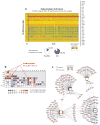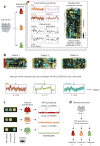Understanding Human Autoimmunity and Autoinflammation Through Transcriptomics
- PMID: 28142321
- PMCID: PMC5937945
- DOI: 10.1146/annurev-immunol-051116-052225
Understanding Human Autoimmunity and Autoinflammation Through Transcriptomics
Abstract
Transcriptomics, the high-throughput characterization of RNAs, has been instrumental in defining pathogenic signatures in human autoimmunity and autoinflammation. It enabled the identification of new therapeutic targets in IFN-, IL-1- and IL-17-mediated diseases. Applied to immunomonitoring, transcriptomics is starting to unravel diagnostic and prognostic signatures that stratify patients, track molecular changes associated with disease activity, define personalized treatment strategies, and generally inform clinical practice. Herein, we review the use of transcriptomics to define mechanistic, diagnostic, and predictive signatures in human autoimmunity and autoinflammation. We discuss some of the analytical approaches applied to extract biological knowledge from high-dimensional data sets. Finally, we touch upon emerging applications of transcriptomics to study eQTLs, B and T cell repertoire diversity, and isoform usage.
Keywords: autoimmunity; autoinflammation; mechanisms; patient stratification; therapeutic targets; transcriptomics.
Figures




References
-
- Stoffels M, Kastner DL. Old dogs, new tricks: monogenic autoinflammatory disease unleashed. Annu Rev Genom Hum Genet. 2016;17:245–72. - PubMed
-
- Maini RN, Brennan FM, Williams R, Chu CQ, Cope AP, et al. TNF-alpha in rheumatoid arthritis and prospects of anti-TNF therapy. Clin Exp Rheumatol. 1993;11(Suppl 8):S173–75. - PubMed
-
- Elliott MJ, Maini RN, Feldmann M, Long-Fox A, Charles P, et al. Treatment of rheumatoid arthritis with chimeric monoclonal antibodies to tumor necrosis factor α. Arthritis Rheum. 1993;36:1681–90. - PubMed
Publication types
MeSH terms
Grants and funding
LinkOut - more resources
Full Text Sources
Other Literature Sources
Medical

